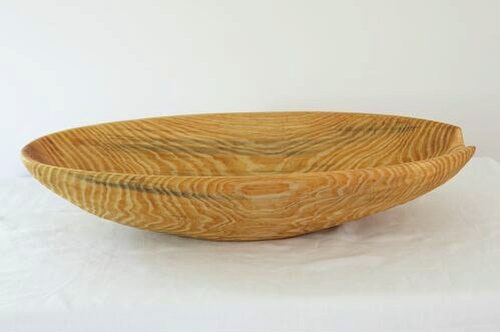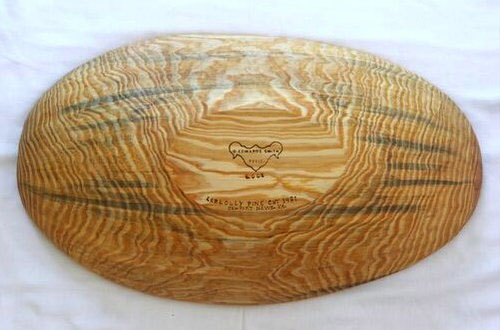
Elliptical Hand Hewn Dough Bowl
I called this bowl "Symmetry Broken." I watched a man hew out bowls with an adz in Berea, Kentucky at the state-run craft center. He used the old trick of two nails and a piece of string to guide a pencil to trace out a perfect ellipse and then used this to guide his tools.
He was quite skilled and made bowls with very thin walls. He used buckeye which was a common wood for making dough bowls or trays in earlier times. I had this big chunk of loblolly pine in my shop. It had been bracing a canoe which was stored vertically in Kentucky and when I moved I almost forgot this piece of wood. I opined that it might be good for something and threw it on the truck.
A year later I decided to make an elliptical hand hewn dough tray. However this was not buckeye as I found out in a hurry. Loblolly pine or Virginia longleaf pine or common yellow pine as it is known in the lumber trade has extremely dense late wood and very soft early wood. In the picture the early wood is light in color and is formed when the tree is growing quickly in the spring. The late wood is darker in color and is formed later in the season when growth conditions are not so good and growth is slower.
This makes a wicked combination to carve. The tool bogs down in the hard wood and when great force is used it flies through the soft, early wood in an uncontrolled manner. I found that the hand adz was useless and had to resort to a curved chisel and firm carver's mallet.
It was slow going for the better part of a year. In spite of the difficulty, the visual effect of the light and dark areas of wood are somewhat pleasing. Overzealous use of the carver's mallet resulted in some wood at the end to chip out. Nothing to do but to accept this. It even makes a good place to rest a spoon handle and some may think it was part of the original design. It wasn't that. So that is why I call it symmetry broken.
In earlier times flour, water, sugar and yeast would be added and let work for some hours to make a "sponge." To this fermenting mixture would be added flour and then the dough kneaded right in the same bowl. Then it would be allowed to rise once, punched down and then separated into loaf pans to rise the second time before baking the bread.
These bowls saw heavy use and were in every pioneer's kitchen. Today they are collected but seldom used for their original purpose. This bowl measures about 28 inches in length. The dark streaks are due to fungus growth in the wood which occurred during the drying process. It is finished with linseed oil which stops any fungal growth. As best I can tell this is equivalent to the spalting that occurs in maple and other wood species but it's appearance in pine is very different, perhaps owing to the structural differences in the species.

